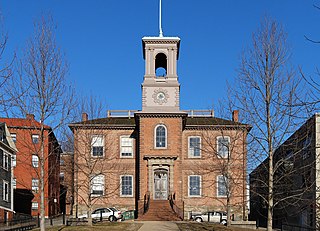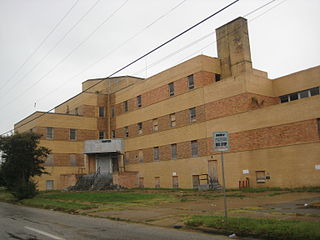
The Virginia School for the Deaf and the Blind, located in Staunton, Virginia, United States, is an institution for educating deaf and blind children, first established in 1839 by an act of the Virginia General Assembly. The school accepts children aged between 2 and 22 and provides residential accommodation for those students aged 5 and over who live outside a 35-mile (56 km) radius of the school

Charles Morrison Robinson, most commonly known as Charles M. Robinson, was an American architect. He worked in Altoona and Pittsburgh, Pennsylvania from 1889 to 1906 and in Richmond, Virginia from 1906 until the time of his death in 1932. He is most remembered as a prolific designer of educational buildings in Virginia, including public schools in Richmond and throughout Virginia, and university buildings for James Madison University, College of William and Mary, Radford University, Virginia State University, University of Mary Washington, and the University of Richmond. He was also the public school architect of the Richmond Public Schools from 1910 to 1929. Many of his works have been listed on the National Register of Historic Places.

The Virginian Railway Passenger Station, also known as the Virginian Station is a former rail station listed on the National Register of Historic Places in the South Jefferson neighborhood of the independent city of Roanoke, Virginia, U.S.A. Located at the intersection of Jefferson Street SE and Williamson Road, the Virginian Station served as a passenger station for the Virginian Railway between 1910 and 1956. The station was the only station constructed with brick along the entire length of the Virginian's 608 miles (978 km) network. It was severely damaged by fire on January 29, 2001.
The East End is an area of the independent city of Newport News, Virginia, located in the older portion of the port city near the harbor of Hampton Roads.

The Old State House on College Hill in Providence, Rhode Island, also known as Providence Sixth District Court House,Providence Colony House, Providence County House, and Rhode Island State House is located on 150 Benefit Street, with the front facade facing North Main Street. It is a brick Georgian-style building largely completed in 1762. It was used as the meeting place for the colonial and state legislatures for 149 years.

Greenlawn Memorial Park, also known as Greenlawn Cemetery, is located at 2700 Parish Avenue, Newport News, Virginia. Greenlawn Memorial Park is a 50-acre (200,000 m2) cemetery located where two natural streams, Mill Dam Creek and Salters Creek, come together. The cemetery has been in continuous operation, serving the Newport News and Hampton, Virginia, since 1888. There are approximately 20,000 burials in the cemetery. Greenlawn Memorial Park is on the National Register of Historic Places.

The first Newport News Public Library, renamed West Avenue Library, now NNPLS Technical Services, in the Newport News Public Library System, was opened on October 14, 1929 at the corner of West Avenue and 30th Street in the City of Newport News, Virginia. This building was the first to be built in Newport News for the express purpose of being a library. In 2005, the West Avenue Library was placed onto the Virginia Landmarks Register and the National Register of Historic Places under its original name of Newport News Public Library. The building now known as West Avenue Library; however it is no longer a functioning library.

The Blues Armory is a large brick armory in downtown Richmond, Virginia. Housing the Richmond Light Infantry Blues, the castle-like structure originally served multiple purposes, with a food market on the ground floor and a drill hall for the National Guard of the United States on the top floor. The level between housed suites of offices for each individual National Guard company. In 1985, the ground floor was converted to retail and restaurant space, part of the 6th Street Marketplace.

Farmington is a house near Charlottesville, in Albemarle County, Virginia, that was greatly expanded by a design by Thomas Jefferson that Jefferson executed while he was President of the United States. The original house was built in the mid-18th century for Francis Jerdone on a 1,753-acre (709 ha) property. Jerdone sold the land and house to George Divers, a friend of Jefferson, in 1785. In 1802, Divers asked Jefferson to design an expansion of the house. The house, since greatly enlarged, is now a clubhouse.

Newport Historic District is a national historic district located at Newport, Giles County, Virginia. It encompasses 50 contributing buildings and 3 contributing sites in the rural village of Newport. The district includes primarily freestanding single-family dwellings or store buildings of one or two stories, featuring wood-frame construction, wood siding or ornamental metal sheathing, front porches, and associated outbuildings. Notable buildings include the Epling-Dunkley[or Dunklee]-Smith House (1820s-1830s), Keister-Miller House (1846), Robert Payne House (1850s), Payne-Price House, the Miller Building, the Pent Taylor Store, the Miller Brothers General Mercantile Store, F.E. Dunkley [Dunklee] Store, Pasterfield House (1903), Dr. Walter Miller House (1903-1904), Albert Price House (1904), Methodist Parsonage (1909), Newport Methodist Church, and Sinking Creek Valley Bank (1927).

Rogers' Store, also known as Gwaltney's Store, is a historic general store located at Carsley near Surry, Surry County, Virginia. It was built about 1894, and is a two-story, three bay by three bay, Late Victorian frame building with a front gable roof. It features a full-width front porch supported by turned posts and a standing seam metal shed roof. Located directly behind the Rogers' Store is the Gwaltney's Store building. It was built in 1827, and is a 1 1/2-story, two room, gable front frame building. With the construction of the new store in 1894, the old store was converted to storage space. The store closed in 1952.

The Hopewell High School Complex, also known as James E. Mallonee Middle School, is a historic former school campus located at 1201 City Point Road in Hopewell, Virginia, United States. Contributing properties in the complex include the original school building, athletic field, club house, concession stand, press box, Home Economics Cottage, gymnasium and Science and Library Building. There are two non-contributing structures on the property.

The Matthew Jones House is a historic plantation house located on Fort Eustis in Newport News, Virginia. The house sits on a hill toward the northern end of Mulberry Island, overlooking the James River. It was built ca. 1725 as a one-and-a-half-story frame dwelling with brick chimneys and later underwent two major renovations. During the first renovation, in 1730, the walls were bricked in and a shed room and porch tower were added. During the second, in 1893, the house was raised to a full two stories. In 1918 the house and its surrounding land were acquired by the U.S. government for the establishment of an army post. By the late twentieth century, the Matthew Jones House had fallen into grave disrepair. In 1993 it was preserved and rehabilitated by the National Park Service in cooperation with the U.S. Army Corps of Engineers. Today it serves as an architectural museum.

James A. Fields House is a historic home located in the Brookville Heights neighborhood in the East End of Newport News, Virginia. It was built in 1897, and is a two-story, Italianate style red brick dwelling on a raised basement. It features an entrance tower with a low pitched hipped roof and two ten-foot tall two-over-two windows on the first floor. It was built by the prominent African-American lawyer and politician James A. Fields (1844–1903) and served as the location of the first black hospital in the city, which later became the Whittaker Memorial Hospital.

Causey's Mill is a historic grist mill located in Causey's Mill Park at Newport News, Virginia. It was built in 1866, and is a small two-story wood-frame building originally supported by a brick and concrete foundation. It retains its original machinery and is one of the two last surviving grist mills on the Peninsula. The mill operated until nearly the 20th century. In 2011, the mill was moved about 75 feet from its original location away from the shore of the Mariners' Lake and set on a new foundation.

Warwick County Courthouses, also known as the Warwick County Courthouse and Clerk's Office, is a historic courthouse and clerk's office located at Newport News, Virginia. The original courthouse was built in 1810, and is a one-story, three-room, T-shaped plan Federal-style brick building. It has a slate-covered gable roof and exterior end chimneys. The building was later enlarged by a side and rear addition. The later courthouse was built in 1884, and is a two-story, Italianate style brick building. It has a rectangular plan and a shallow metal-covered hipped roof with three shallow cross gables. It features a square wood bell cupola that rises above the central projecting bay. Also on the property is a contributing Confederate monument dedicated in 1909. The buildings housed county offices until 1958, when Warwick County, Virginia was annexed by Newport News.

Hotel Warwick is a historic hotel building located at Newport News, Virginia. It was built in 1928, and is a seven-story, brick building in an eclectic Gothic Revival / Art Deco style. It features terra cotta tile ornamentation and a continuous terra cotta and brick false parapet. A two-story addition was added to the rear of the building in 1962. It was the first skyscraper, first tower hotel and first fireproof hotel in Newport News. It replaced an earlier Hotel Warwick built by Collis Potter Huntington in 1883.

Whittaker Memorial Hospital is a historic hospital building located in the Brookville Heights neighborhood in the East End of Newport News, Virginia. The original section was built in 1943 with additions in 1957 and 1966. The earliest portion of the building has a symmetrical "T"-plan with both Moderne and Art Deco influences. It has a concrete frame, with concrete roof and floor slabs, and curtain walls constructed of alternating bands of yellow and brown bricks. The central mass is three stories tall and has two-story wings. The Whittaker Memorial Hospital was founded in 1908 to serve the African-American population of Newport News. The hospital was built by African-American physicians and designed by African-American architects. It was originally housed in the James A. Fields House, then in a frame hospital built in 1915 before this building was constructed in 1943. The hospital closed in 1985.

Medical Arts Building is an American historic medical office building located at Newport News, Virginia. It was designed by architect Charles M. Robinson and built in 1928. It was listed on the National Register of Historic Places in 2002.
North End Historic District is a national historic district located at Newport News, Virginia. It encompasses 451 contributing buildings in a primarily residential section of Newport News. It is a compact, middle-class and upper middle-class residential neighborhood that arose during the period 1900–1935 in association with the nearby Newport News Shipbuilding and Dry Dock Company. The neighborhood includes notable examples of the Victorian, Colonial Revival, and Bungalow styles. Notable buildings include the Walter A. Post House (1902), John Livesay House (1906), J. E. Warren House (1905), W. L. Shumate House (1915), and Willet House.






















